What pension type are you? What pension type are you?
Find out with the help of our three examples, and secure the best possible provision for your dreams with frankly vested benefits.
Find out with the help of our three examples, and secure the best possible provision for your dreams with frankly vested benefits.

Retirement planning at any stage in life
There are several reasons to transfer your pension assets from your pension fund to frankly, for example if you are taking a career break, lose your job, give up gainful employment or become self-employed. frankly offers you a range of products for many of life’s situations.
Felix, 50, changes to a job with a pension fund with lower regulatory benefits
Felix, 50, changes to a job with a pension fund with lower regulatory benefits
Let’s assume you are Felix, 50 years old, and you work as a senior consultant at a university hospital. Thanks to your high salary, in recent years you have been able to make additional contributions into the pension fund to ensure you are well covered in old age. However, you now want to realise your childhood dream of speeding down the motorway as an HGV driver. You soon find a new employer. When you come to transfer your termination benefit to the new pension fund, you are informed that you don't need to contribute the full amount of your termination benefit to purchase the full regulatory benefits. Your new pension fund therefore agrees to allow you to transfer the surplus portion to a vested benefits account of your choice.
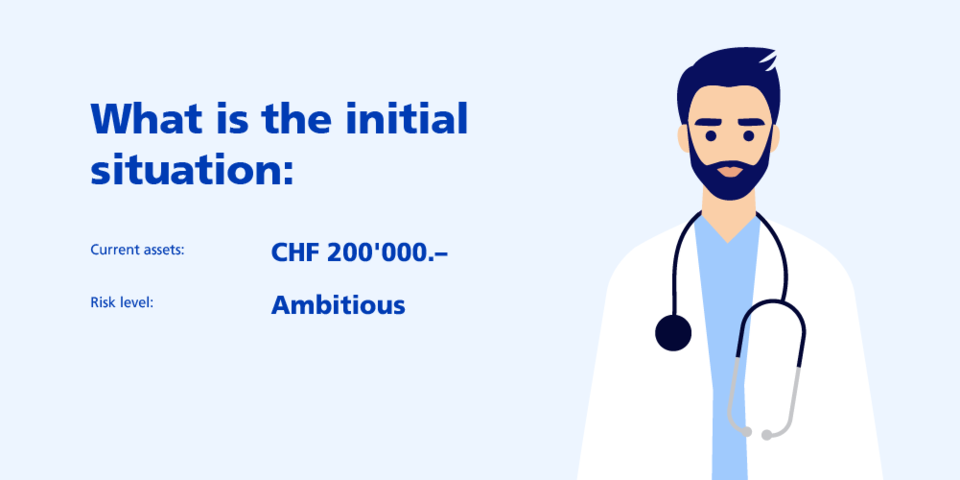
Possible investment product: Strong 75 Responsible
Felix opts for a sustainable, active investment product that contains a high equity component (75%). This equity component exceeds the maximum amount of 50% which applies under the investment regulations for pension fund assets. The investment product is therefore only suitable for pension fund members with a very long investment horizon and a high risk capacity and tolerance. The objectives of the investment product are to achieve long-term capital growth and to generate additional income. In exchange for this, Felix is willing to accept higher risk. Active investment products are also designed to “beat the market”, i.e. to achieve a better investment performance than the market average.
Note: Strong 75 Responsible exceeds BVV2 category limits
What kind of pension could Felix achieve with frankly by the time he retires?
Estimated pension assets at age 70 or in 20 years:
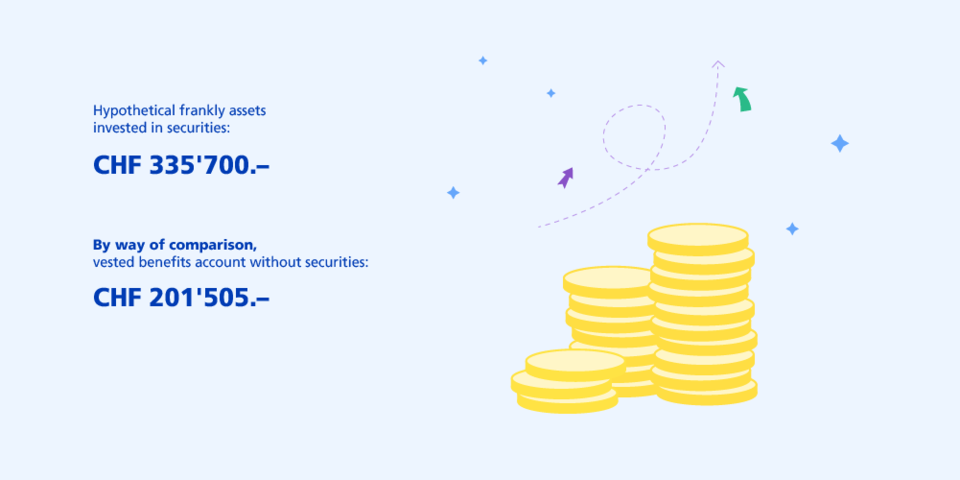
Statement of changes in net assets
If Felix were to just leave his money in a vested benefits account, in 15 years’ time, assuming interest rates remain low at 0.05%, he would have CHF 201,505. If he were to save in securities, however, with a hypothetical return of 4.06% per year (net after costs) this could rise to CHF 335,700.
The savings you can make with securities are worth much more than just a few hundred francs. Felix, for example, is 50 years old and in employment. He makes a one-off payment of CHF 200,000 into his vested benefits account with frankly, and he chooses an investment product with an equity component of 75%.
Lukas, 55, is giving up his gainful employment and becoming a person of independent means
Lukas, 55, is giving up his gainful employment and becoming a person of independent means
Let’s say you are Lukas, 55 years old, and you are leaving your job at a consulting firm after a long career. However, you are not yet ready to retire completely, so you plan to provide consulting/advisory services in a self-employed capacity until you reach normal retirement age. You decide to not withdraw your vested benefits until you reach the age of 65. Until then, you invest the retirement assets you have accumulated over the years with frankly vested benefits.
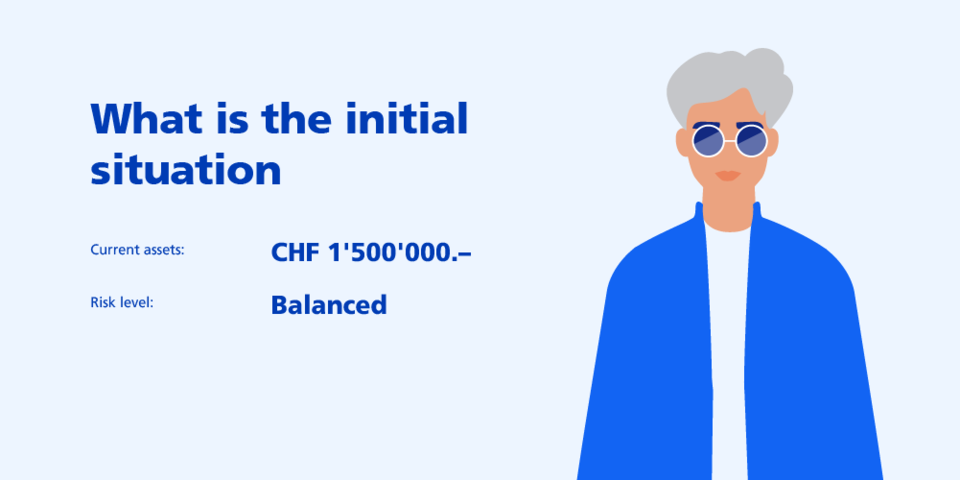
Possible investment product: Moderate 45 Responsible
Lukas opts for a sustainable, active investment product that contains a medium equity component (45%). The objectives of the investment product are to achieve long-term capital gains and to generate income. However, Lukas is risk tolerant without taking major risks, since his investment product also consists of 40% bonds and 15% real estate. Active investment products are also designed to “beat the market”, i.e. to achieve a better investment performance than the market average.
What kind of pension could Lukas achieve with frankly by the time he retires?
Estimated pension assets at age 65 or in 10 years:
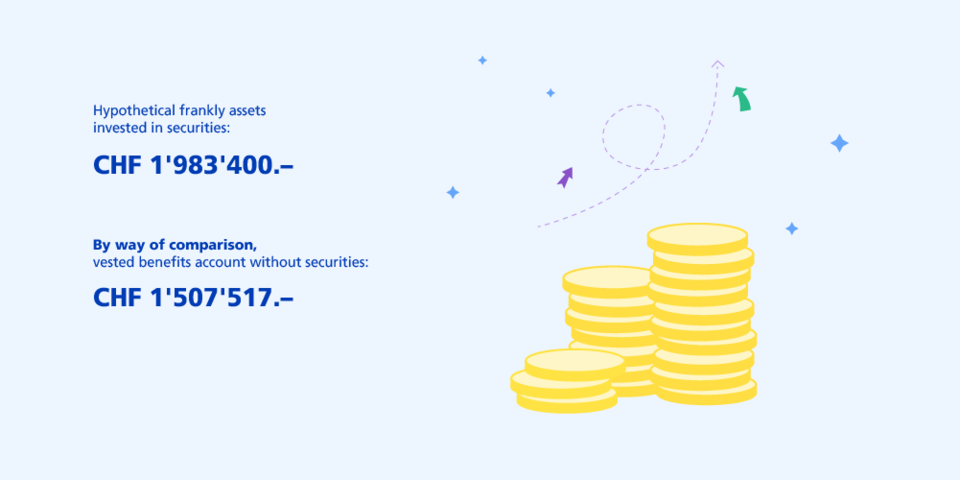
Statement of changes in net assets
If Lukas were to leave his money in his original normal vested benefits account, in 10 years’ time and assuming interest rates remain low at 0.05%, he would have CHF 1,507,517. If he were to save in securities, however, with a hypothetical return of 3.06% per year (net after costs) this could rise to CHF 1,983,400.
The savings you can make with securities are worth much more than just a few hundred francs. Lukas, for example, is 55 years old and in employment. He makes a one-off payment of CHF 1,500,000 into his vested benefits account with frankly, and he chooses an investment product with an equity component of 45%.
Marina, 32 years old, new mum
Marina, 32 years old, new mum
Let’s say you’re Marina, 32, and you’ve just become a mum for the first time. You want to take on parental responsibility at home and take a break from work following the birth of your first child. You don't yet know when exactly you will return to work. You would also like to buy your own home for your family in the future. To finance this, you would draw on your vested benefits assets.
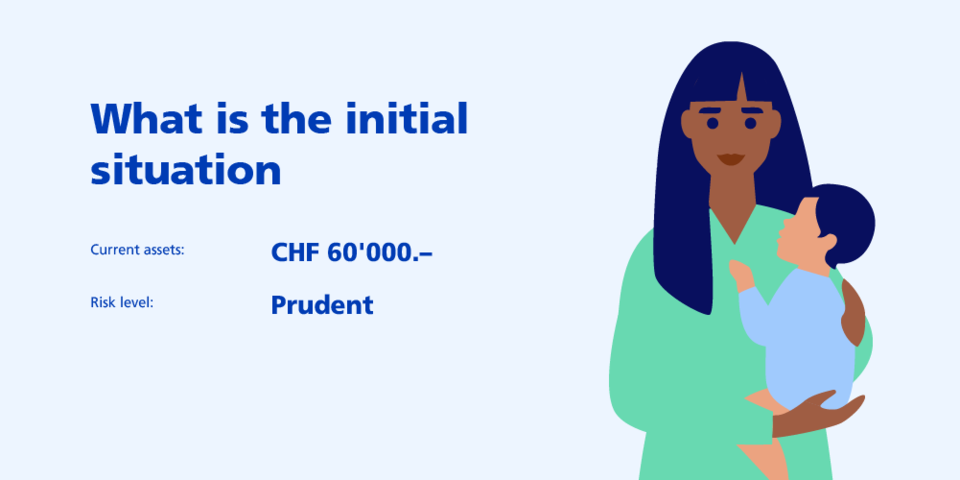
Possible investment product: Light 15 Responsible
Marina opts for a security-conscious investment strategy – also because she might want to draw down the assets to purchase a home. With this investment strategy, Marina can preserve her assets and generate regular returns. Investments are primarily made in bonds. Equities and other investments may also be included in the mix for the purpose of optimisation.
What kind of pension could Marina achieve with frankly by this time?
Estimated pension assets in 3 years or at age 35:
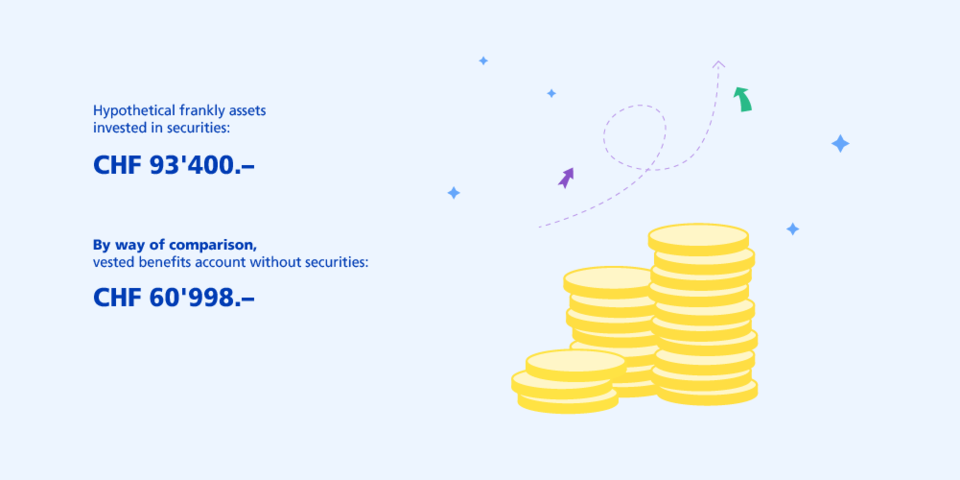
Statement of changes in net assets
If Marina were to leave her money in her normal vested benefits account, in 3 years’ time and assuming interest rates remain low at 0.05%, she would have CHF 60,998. If she were to save in securities, however, with a hypothetical return of 1.46% per year (net after costs) this could rise to CHF 93,400.
The savings you can make with securities are worth much more than just a few hundred francs. Marina, for example, is 32 years old and not in employment. She makes a one-off payment of CHF 60,000 into her vested benefits account with frankly, and she chooses an investment product with an equity component of 15%.
Melanie, 42, is undertaking further education
Melanie, 42, is undertaking further education
Let’s assume you are Melanie, 42 years old, and you work as a teacher at a secondary school. You always wanted to be a pianist and now finally have the opportunity to take a career break to pursue this ambition. While studying at the Zurich Conservatory, you will transfer your existing pension fund assets to a vested benefits institution.
Melanie opts for an account strategy that pays interest on her balance at a current rate of 0.05%. Since Melanie will return to her job as a teacher in a year’s time, investing her pension fund assets in securities is too risky for her. She makes a one-off payment of CHF 250,000 into her vested benefits account with frankly, and she chooses the account strategy with no risk.
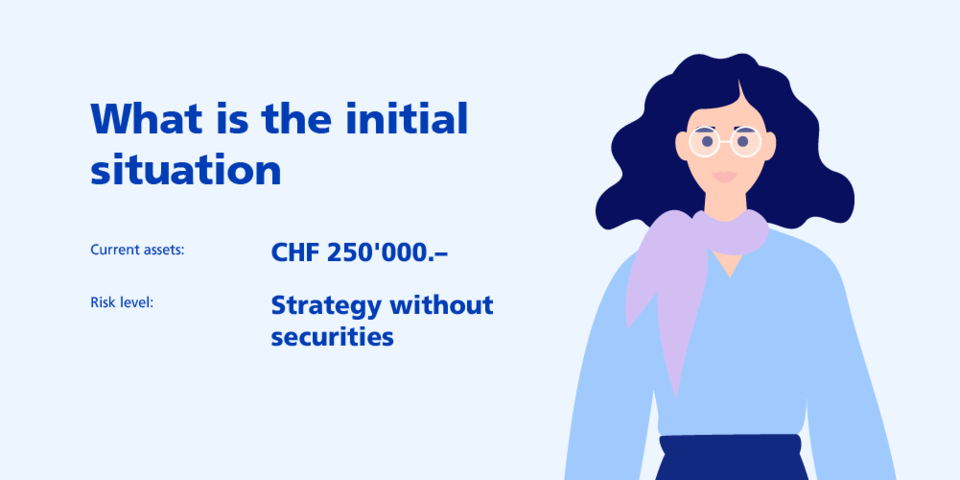
Statement of changes in net assets
If Melanie were to leave her money in her normal vested benefits account, in a year’s time and assuming interest rates remain low at 0.40%, she would have CHF 250,125.
Sara, 30, decides to start her own business
Sara, 30, decides to start her own business
Let’s assume you are Sara, 30 years old, and you work as a graphic designer at an advertising agency. After a few years in the profession, you now want to explore new avenues and open your own small graphic design office. As somebody who is self-employed you are no longer insured as a pension fund member, but would like to invest your current assets sensibly. You also decide not to withdraw your pension fund assets for your self-employment, even though this would be legally possible.
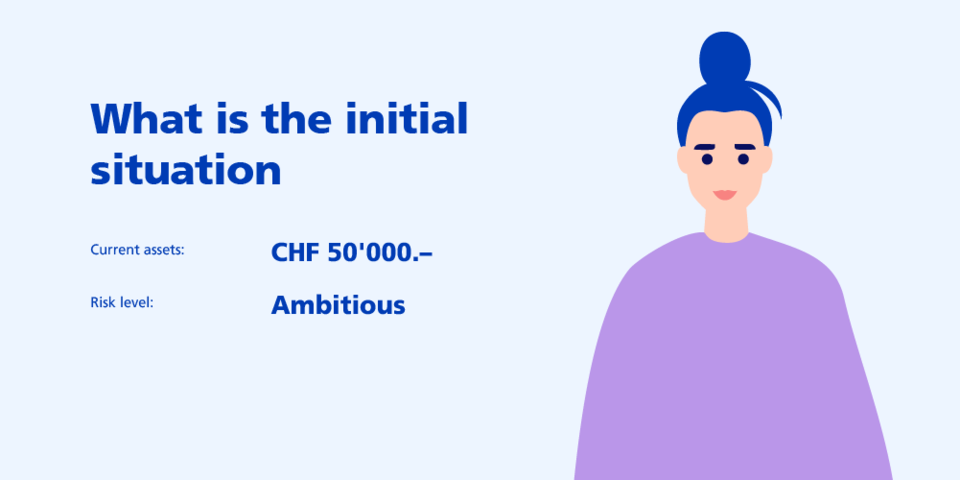
Possible investment product: Strong 75 Responsible
Sara opts for a sustainable, active investment product that contains a high equity component (75%). This equity component exceeds the maximum amount of 50% which applies under the investment regulations for pension fund assets. The investment product is therefore only suitable for pension fund members with a very long investment horizon and a high risk capacity and tolerance. The objectives of the investment product are to achieve long-term capital growth and to generate additional income. In exchange, Sara is willing to accept higher risk. Active investment products are also designed to “beat the market”, i.e. to achieve a better investment performance than the market average.
Note: Strong 75 Responsible exceeds BVV2 category limits
What kind of pension could Sara achieve with frankly by the time she retires?
Estimated pension assets at age 65 or in 35 years:
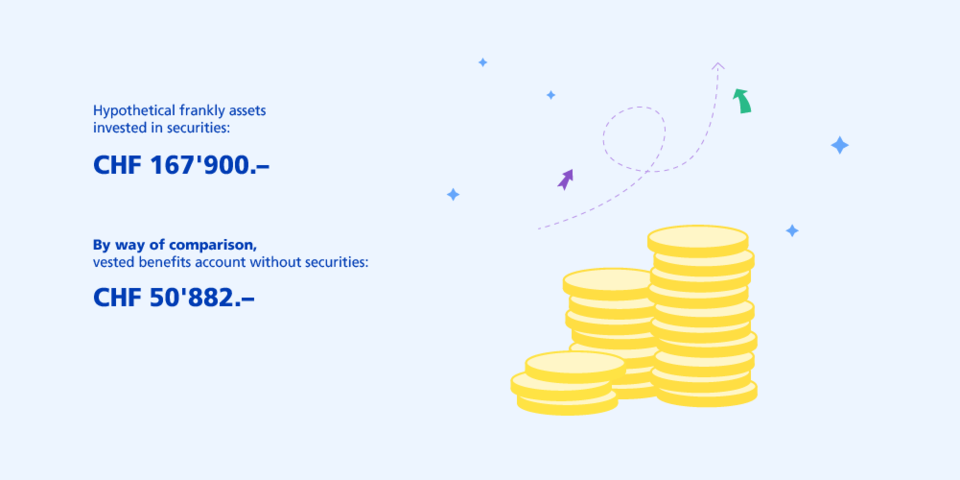
Statement of changes in net assets
If Sara were to leave her money in her vested benefits account, in 35 years’ time and assuming interest rates remain low at 0.05%, she would have CHF 50,882. If she were to save in securities, however, with a hypothetical return of 4.06% per year (net after costs) this could rise to CHF 167,900.
The savings you can make with securities are worth much more than just a few hundred francs. Sara, for example, is 30 years old and is self employed. She makes a one-off payment of CHF 50,000 into her vested benefits account with frankly, and she chooses an investment product with an equity component of 75%
Calculation and risk information
Let's assume, for example: an equity component of 75% and a hypothetical return per year of 4.06% (net after costs).
General calculation and risk information
The future returns and risks presented here are for illustrative purposes only. Securities savings may fluctuate, the hypothetical return cannot be guaranteed and tax effects are not included in this forecast.
Economic models and statistical methods are used for calculation purposes. The forecast corresponds with the most likely performance, and can be predicted for an investment horizon of up to 10 years. In the event of a longer investment horizon the calculations are continued using the same values, whereby no statements can be made about the probability of the calculated results occurring. In the event of very unfavourable market developments, the performance may be lower than the nominal savings value. The calculated values are net of the frankly all-in fee and are based on an interest rate on the vested benefits account of 0.05%. Please note that inflation and the taxes payable when the balance becomes due are not included in this forecast.